Table of contents
India’s villages are brimming with untapped potential. With a growing focus on rural development and entrepreneurship, starting a business in a village can be a rewarding and profitable venture. Here are 10 of the best village business ideas to start in India, tailored for success and sustainability.
Why Village Businesses Can Be Easier to Start
While challenges exist, village businesses often present certain advantages that make them easier to launch than urban enterprises:
- Lower Startup Costs:
- Land and workspace are often more affordable in rural areas.
- Labor costs can be lower, especially with family involvement.
- Raw materials are often locally sourced, reducing transportation expenses.
- Access to Local Resources:
- Villages often have abundant natural resources like agricultural produce, raw materials for handicrafts, and livestock.
- Traditional skills and knowledge are readily available within the community.
- Existing social networks can provide valuable support and customer base.
- Less Competition:
- Many villages have fewer businesses compared to urban areas, reducing direct competition.
- Niche markets and specialized products can thrive due to the lack of alternatives.
- Simpler Regulatory Environment:
- Some rural businesses may require fewer licenses and permits compared to urban counterparts.
- Local panchayats and authorities can provide easier access to information and support.
- Strong Community Support:
- Villagers often support local businesses, fostering a sense of community and loyalty.
- Family and friends can provide initial labor and capital.
- Word of mouth advertising is very effective in villages.
- Flexibility and Adaptability:
- Many village businesses can be started on a smaller scale, and expanded slowly.
- It is easier to adapt to changing local needs.
10 Best Village Business Ideas
1. Organic Farming

Organic farming involves cultivating crops and raising livestock using natural, sustainable methods. This means avoiding synthetic pesticides, herbicides, fertilizers, and genetically modified organisms (GMOs). Instead, it relies on techniques like crop rotation, composting, vermicomposting, and natural pest control.
a. Why this Idea:
- Growing health consciousness among consumers driving demand for organic produce.
- Higher profit margins due to premium pricing of organic products.
- Sustainable agriculture practices contribute to environmental health and soil fertility.
- Government initiatives and subsidies support organic farming.
b. Licenses Required:
- FSSAI (Food Safety and Standards Authority of India) registration for food products.
- Organic certification (e.g., PGS-India or NPOP) to validate organic claims.
c. Investment Required:
- Moderate: Land acquisition or lease, organic seeds, natural fertilizers (compost, vermicompost), basic farming equipment, and labor.
d. How to Sell:
- Direct sales to consumers through farmers’ markets, community-supported agriculture (CSA), and online platforms.
- Supplying organic stores, restaurants, and hotels.
- Collaborating with e-commerce platforms specializing in organic products.
e. Any other Requirements:
- Knowledge of organic farming techniques, including crop rotation, natural pest control, and soil management.
- Access to suitable land and water resources.
- Proper storage and handling facilities.
f. Challenges in the Idea:
- Initial setup costs and longer gestation periods compared to conventional farming.
- Controlling pests and diseases without synthetic pesticides.
- Navigating the certification process.
g. How to overcome the Challenges:
- Start with a small-scale operation and gradually expand.
- Employ natural pest control methods like companion planting and beneficial insects.
- Seek guidance from agricultural experts and participate in training programs.
h. Example: A farmer specializes in growing heirloom tomatoes and leafy greens using vermicompost and neem-based pesticides. They establish a weekly stall at the local market and offer a subscription box service for regular customers, emphasizing the unique flavors and nutritional benefits of their produce.
2. Dairy Farming

Dairy farming involves raising cows or buffaloes for milk production. The milk is then sold fresh or processed into various dairy products like ghee, paneer, curd, and butter.
a. Why this Idea:
- Consistent demand for milk and dairy products in India.
- Potential for value-added products like ghee, paneer, curd, and flavored milk.
- Government schemes and loans supporting dairy farming.
b. Licenses Required:
- FSSAI registration for dairy products.
- Animal husbandry permits from the local authorities.
c. Investment Required:
- Moderate to high: Livestock purchase, shed construction, milking equipment, feed, and veterinary care.
d. How to Sell:
- Supplying milk to local dairies and milk collection centers.
- Direct sales to consumers through home delivery or retail outlets.
- Selling value-added dairy products to local shops and restaurants.
e. Any other Requirements:
- Knowledge of animal husbandry, including feeding, breeding, and disease management.
- Access to suitable grazing land and water resources.
- Maintaining hygiene and sanitation in the dairy farm.
f. Challenges in the Idea:
- Livestock diseases and health issues.
- Fluctuations in feed costs.
- Milk preservation and transportation.
g. How to overcome the Challenges:
- Regular veterinary checkups and vaccination programs.
- Efficient feed management and fodder cultivation.
- Investing in cold storage and transportation facilities.
h. Example: A family establishes a dairy farm with indigenous Gir cows, producing A2 milk and traditional ghee. They emphasize the health benefits of their products and sell them directly to health-conscious consumers and Ayurvedic clinics.
ALSO READ | 10 Highly Profitable Manufacturing Business Ideas Under ₹50,000
3. Handicraft Making
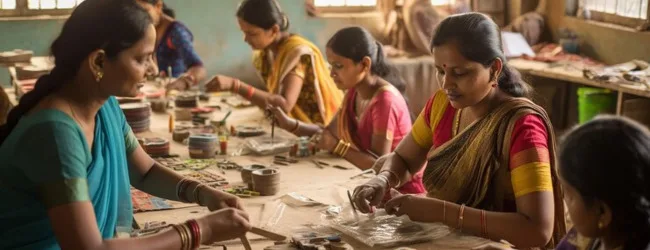
Handicraft making involves creating and selling traditional crafts using local materials and techniques. This can include pottery, weaving, basketry, wood carving, embroidery, and other artisanal products.
a. Why this Idea:
- Rich cultural heritage and traditional crafts in Indian villages.
- Growing demand for handmade and unique products.
- Tourism potential and export opportunities.
b. Licenses Required:
- Artisan registration with relevant government bodies.
- GST registration (if applicable).
c. Investment Required:
- Low to moderate: Raw materials, tools, workspace, and marketing expenses.
d. How to Sell:
- Local markets, craft fairs, and exhibitions.
- Online platforms and e-commerce websites.
- Tourist shops and souvenir outlets.
e. Any other Requirements:
- Artistic skills and knowledge of traditional crafts.
- Sourcing high-quality raw materials.
- Quality control and packaging.
f. Challenges in the Idea:
- Competition from mass-produced products.
- Sourcing raw materials and maintaining consistent quality.
- Marketing and reaching a wider audience.
g. How to overcome the Challenges:
- Create unique designs and offer customization options.
- Establish direct relationships with raw material suppliers.
- Utilize online marketing and social media to promote products.
h. Example: A group of women creates hand-woven textiles using natural dyes and traditional motifs. They collaborate with local designers to create contemporary apparel and home decor items, selling them through online platforms and craft fairs.
💡 Pro Tip: If you want to start a Business but have too many doubts, connect with a Business expert from Boss Wallah for guidance – https://bw1.in/1116
4. Poultry Farming
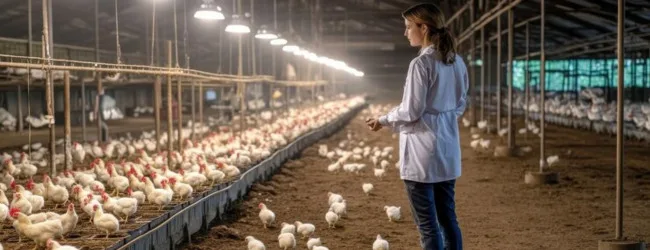
Poultry farming involves raising chickens, ducks, or other birds for meat and egg production.
a. Why this Idea:
- High demand for poultry products due to their affordability and nutritional value.
- Quick returns and manageable scale of operation.
- Potential for value-added products like processed meat and eggs.
b. Licenses Required:
- Animal husbandry permits from the local authorities.
- FSSAI registration for meat and egg products.
c. Investment Required:
- Moderate: Chicks, feed, shed construction, equipment, and veterinary care.
d. How to Sell:
- Local markets, meat shops, and restaurants.
- Direct sales to consumers.
- Supplying eggs to bakeries and confectionery shops.
e. Any other Requirements:
- Knowledge of poultry management, including feeding, disease control, and hygiene.
- Maintaining proper sanitation and biosecurity measures.
f. Challenges in the Idea:
- Disease outbreaks and mortality rates.
- Fluctuations in feed costs.
- Market price volatility.
g. How to overcome the Challenges:
- Vaccination programs and disease prevention measures.
- Efficient feed management and sourcing affordable feed.
- Market research and diversification of sales channels.
h. Example: A farmer raises country chickens (desi murghi) known for their flavorful meat and nutritious eggs. They sell their products directly to local consumers and restaurants, emphasizing the natural and healthy aspects of their poultry.
5. Flour Mill (Atta Chakki)

A flour mill, or “atta chakki,” grinds grains like wheat, millet, and maize into flour for local consumption.
a. Why this Idea:
- Basic necessity and consistent demand for flour.
- Low competition in rural areas.
- Potential for value-added products like multigrain flour and besan.
b. Licenses Required:
- Trade license from the local authorities.
- FSSAI registration for food products.
c. Investment Required:
- Moderate: Grinding machine, workspace, raw materials, and packaging.
d. How to Sell:
- Direct sales to consumers.
- Supplying flour to local bakeries, restaurants, and small shops.
e. Any other Requirements:
- Reliable power supply.
- Maintaining hygiene and sanitation.
- Quality control of raw materials and finished products.
f. Challenges in the Idea:
- Competition from larger mills and branded flour.
- Maintaining quality and consistency.
g. How to overcome the Challenges:
- Focus on fresh, high-quality flour and offer customized grinding services.
- maintain clean machines, and quality control.
h. Example: A family sets up a small flour mill using traditional stone grinding methods, offering fresh, whole-grain flour to local households and bakeries, emphasizing the nutritional benefits.
6. Vermicomposting
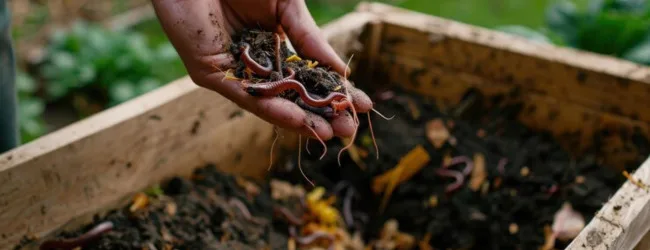
Vermicomposting involves using earthworms to decompose organic waste into nutrient-rich compost, which is then sold as fertilizer.
a. Why this Idea:
- Growing demand for organic fertilizers in agriculture and horticulture.
- Low investment and high returns.
- Eco-friendly and sustainable practice.
b. Licenses Required:
- No specific license required, but quality standards are important.
c. Investment Required:
- Low: Earthworms, compost pits, raw materials (organic waste), and basic tools.
d. How to Sell:
- Local farmers, nurseries, and gardening enthusiasts.
- Online platforms and e-commerce websites.
e. Any other Requirements:
- Knowledge of vermicomposting techniques.
- Suitable space and environment for earthworms.
f. Challenges in the Idea:
- Maintaining optimal conditions for earthworms.
- Marketing and reaching potential customers.
g. How to overcome the Challenges:
- Controlled environment and proper management of compost pits.
- Educating farmers about the benefits of vermicompost.
- Online marketing and good packaging.
h. Example: A group of women starts a vermicomposting unit using locally sourced organic waste, selling high-quality vermicompost to nearby farmers and nurseries, promoting sustainable agriculture.
ALSO READ | Start an Online Marketing Home based Business : Step-by-Step Guide for 2025
7. Tailoring and Garment Making
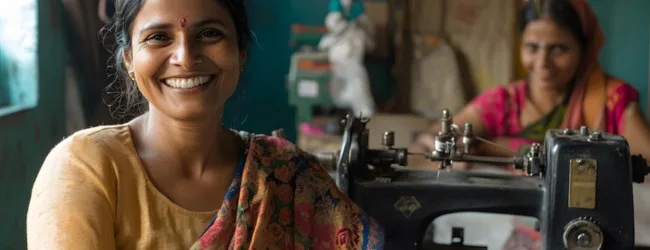
Tailoring and garment making involves providing sewing services and creating custom-made clothing.
a. Why this Idea:
- Basic necessity and demand for customized clothing.
- Potential for local fashion and design.
b. Licenses Required:
- Trade license from the local authorities.
- GST registration (if applicable, based on turnover).
c. Investment Required:
- Low to moderate: Sewing machines, fabrics, threads, workspace, and basic tools.
d. How to Sell:
- Direct sales to customers.
- Local boutiques and fashion stores.
- Online platforms and social media.
- Offering alteration and repair services.
e. Any other Requirements:
- Sewing skills and knowledge of garment construction.
- Knowledge of fashion trends and design.
- Quality control and attention to detail.
- Good customer service.
f. Challenges in the Idea:
- Competition from ready-made garment stores.
- Maintaining quality and meeting customer expectations.
- Managing inventory and sourcing fabrics.
g. How to overcome the Challenges:
- Offer unique designs and customization options.
- Focus on high-quality craftsmanship and personalized service.
- Build a strong customer base through referrals and word-of-mouth.
- Utilize social media to show off your work.
h. Example: A tailor specializes in creating traditional Indian garments with modern designs, offering customized fitting and high-quality stitching, attracting local customers and online orders. They also provide repair and alteration services, creating a loyal customer base.
8. Rural Tourism/Homestays

Rural tourism and homestays involve offering tourists the opportunity to experience village life and culture.
a. Why this Idea:
- Growing interest in rural tourism and authentic travel experiences.
- Potential for cultural exchange and income generation.
- Opportunity to promote local arts, crafts, and cuisine.
b. Licenses Required:
- Tourism permits from the state tourism department.
- Local panchayat permissions.
- Depending on the area, other local permits.
c. Investment Required:
- Moderate: Renovating rooms, providing basic amenities, marketing, and training.
d. How to Sell:
- Online travel platforms and booking websites.
- Local tourism offices and travel agencies.
- Social media and travel blogs.
- Word of mouth referrals.
e. Any other Requirements:
- Clean and comfortable accommodation.
- Knowledge of local attractions and activities.
- Hospitality skills and cultural sensitivity.
- Ability to provide meals.
f. Challenges in the Idea:
- Attracting tourists and managing bookings.
- Maintaining hygiene and safety standards.
- Managing logistics and transportation.
g. How to overcome the Challenges:
- Online marketing and collaboration with travel agencies.
- Ensuring quality service and personalized experiences.
- Providing transportation and tour guide services.
h. Example: A family converts a portion of their traditional house into a homestay, offering authentic village experiences, including local cuisine, cultural activities, and guided tours of nearby attractions. They partner with local artisans to showcase their crafts and organize cultural performances.
9. Local Food Processing
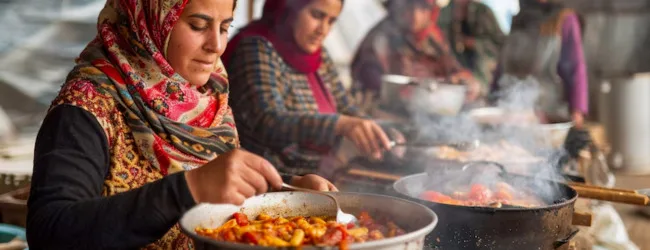
Local food processing involves turning local produce into value-added products like pickles, jams, snacks, and spices.
a. Why this Idea:
- Abundance of local produce and traditional recipes.
- Demand for traditional and homemade food products.
- Potential for branding and marketing.
b. Licenses Required:
- FSSAI registration for food products.
- Trade license from the local authorities.
c. Investment Required:
- Moderate: Processing equipment, packaging materials, raw materials, and storage facilities.
d. How to Sell:
- Local markets and grocery stores.
- Online platforms and e-commerce websites.
- Direct sales to consumers.
- Local fairs, and events.
e. Any other Requirements:
- Knowledge of food processing and preservation techniques.
- Hygiene maintenance and quality control.
- Packaging and labeling skills.
f. Challenges in the Idea:
- Maintaining quality and consistency.
- Extending shelf life and ensuring food safety.
- Marketing and distribution.
g. How to overcome the Challenges:
- Standardized recipes and quality control measures.
- Proper packaging and preservation techniques.
- Online marketing and collaboration with retailers.
h. Example: A group of women prepares and sells traditional pickles and papads using locally sourced ingredients, focusing on authentic recipes and high-quality packaging, attracting local and online customers. They emphasize the natural ingredients and traditional preparation methods.
10. Seed Supply Busines

This business focuses on providing local farmers with high quality seeds.
a. Why this Idea:
- Essential for farming, consistent demand.
- Potential to provide specialized seeds for local crops.
- Opportunity to improve local agricultural productivity.
b. Licenses Required:
- Trade license from the local authorities.
- Seed dealer license from the agriculture department.
c. Investment Required:
- Moderate: Storage facilities, supplier connections, transportation, and marketing.
d. How to Sell:
- Direct sales to local farmers.
- Agricultural supply stores and cooperatives.
- Online platforms and seed catalogs.
e. Any other Requirements:
- Knowledge of seed varieties and quality.
- Storage facilities to maintain seed viability.
- Reliable supplier connections.
f. Challenges in the Idea:
- Ensuring seed quality and authenticity.
- Managing inventory and storage.
- Competition from established seed companies.
g. How to overcome the Challenges:
- Sourcing seeds from reputable suppliers and conducting quality checks.
- Maintaining proper storage conditions and inventory management.
- Providing reliable information and customer service.
h. Example: A local business specializes in supplying high-quality seeds of indigenous crop varieties, focusing on climate-resilient and high-yielding seeds. They provide farmers with information on seed selection and planting techniques, building trust and loyalty.
Need Expert Guidance?
Starting a business can be challenging, but you don’t have to do it alone! At Boss Wallah, our 2,000+ business experts are ready to provide valuable insights and guidance. Whether you need help with marketing, finance, sourcing, or any other area of any business, our business experts are here to help you succeed- https://bw1.in/1116
Confused about Which Business to Start?
Want to start your own business but unsure which one to choose? Explore Boss Wallah, where you’ll find 500+ courses by successful business owners, featuring practical, step-by-step guides on starting and growing various businesses. Find your perfect business idea today – https://bw1.in/1111
Conclusion
India’s villages offer a wealth of opportunities for aspiring entrepreneurs. By leveraging local resources, traditional skills, and growing market demands, these 10 business ideas can help create sustainable livelihoods and contribute to rural development.
Frequently Asked Questions (FAQs)
1 . What are the most profitable village businesses?
- Organic farming, dairy farming, and local food processing often have high profitability potential.
2 . What is the best small business to start in a village?
- Tailoring, flour mills, and vermicomposting are good options with lower initial investments.
3 . How can I get funding for a village business?
- Government schemes, bank loans, and microfinance institutions offer funding options.
4 . What licenses are required to start a business in a village?
- Licenses vary depending on the business, but trade licenses, FSSAI registration, and panchayat permissions are common.
5 . How can I market my village business?
- Online platforms, local markets, social media, and word-of-mouth referrals are effective marketing strategies.
6 . How can I ensure the quality of my products?
- Implementing quality control measures, using high-quality raw materials, and maintaining hygiene standards are crucial.
7 . What are the challenges of starting a business in a village?
- Limited access to resources, infrastructure, and markets can be challenging.
8 . How can I overcome these challenges?
- Planning well, using local resources efficiently, and leveraging online platforms can help.


